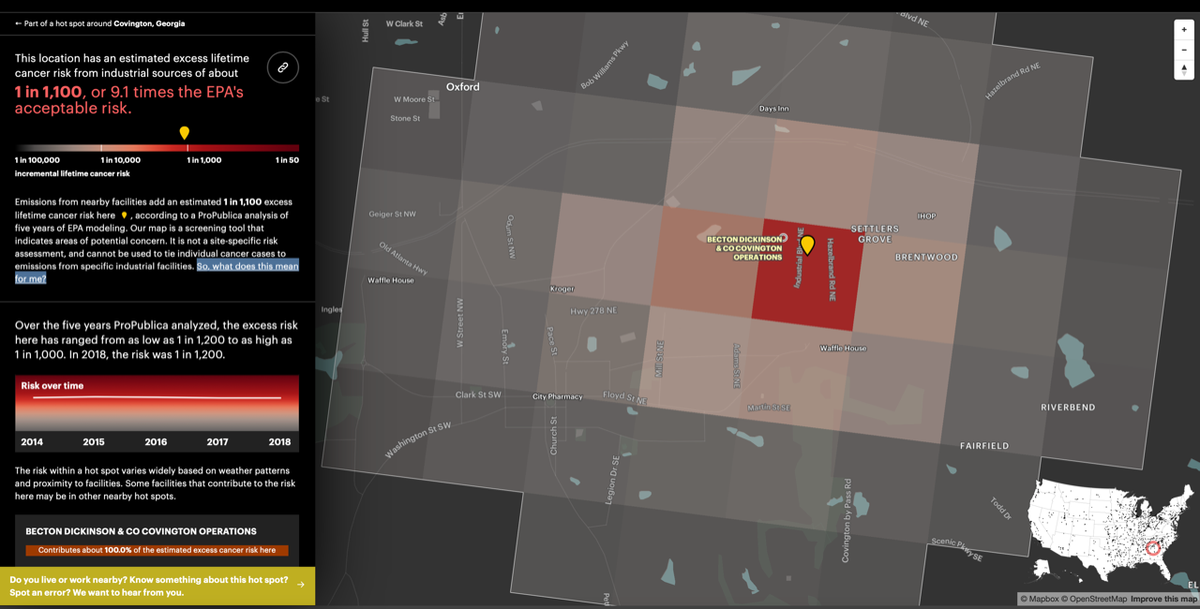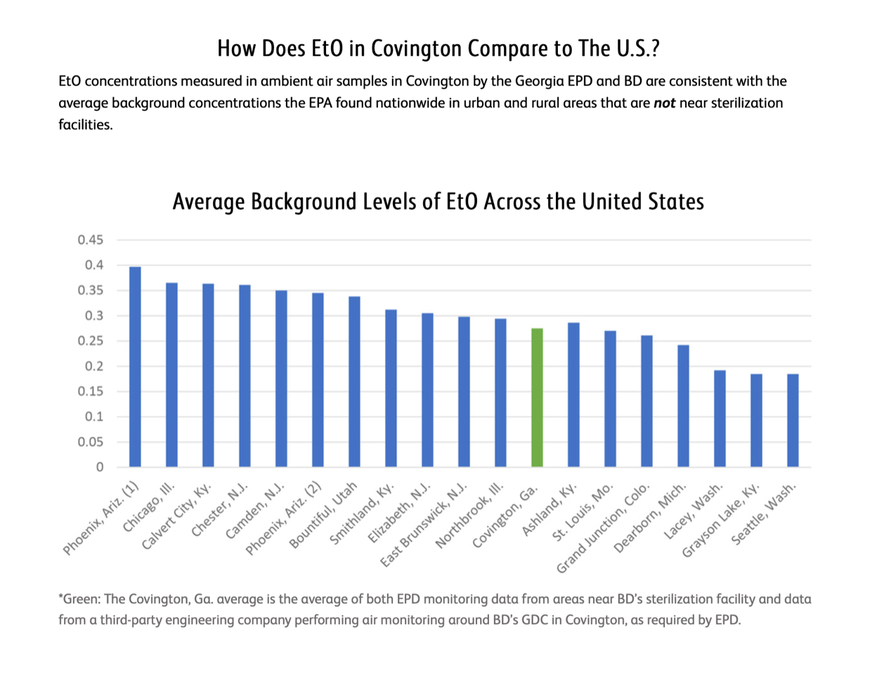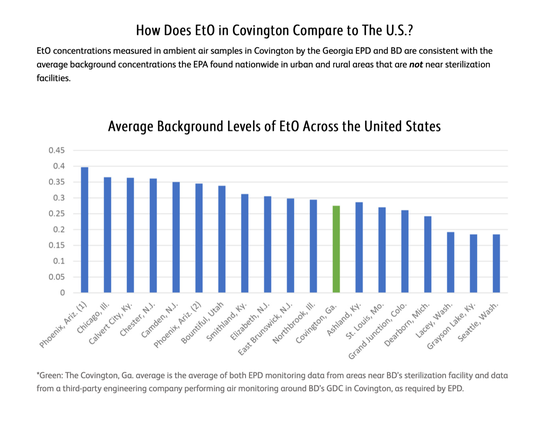COVINGTON, Ga. — An area company scrutinized in years past for its ethylene oxide (EtO) emissions was recently put back under the microscope.
A five-year analysis of Environmental Protection Agency (EPA) modeling recently mapped out and published by nonprofit news company ProPublica shows that EtO emissions from Becton Dickinson & Co. in Covington added an estimated 1 in 1,100 excess lifetime cancer risk within the community — approximately 9.1 times the EPA’s acceptable risk. The map features several industrial facilities located across the U.S. in addition to BD.
However, in a phone interview with The Covington News, BD officials said data from the report was outdated and not based on real air monitoring, and the overall report on BD could easily be “misunderstood.”
“The ProPublica article reports that [it] relies on computer modeling based on data collected from different sources to project emissions over a period from 2014 to 2018,” BD Vice President of Public Relations Troy Kirkpatrick initially stated. “ProPublica did not report on the vast amount of data available from actual air sampling and additional modeling around Covington and greater Atlanta. Actual air monitoring, provides better data on which to understand realized levels of EtO in the air versus computer models.”
ProPublica did state that its map was “built using data modeled from the EPA’s Toxics Release Inventory, and “because this data is self-reported by the facilities and not always vetted for accuracy by the EPA, we’ve found that it may contain errors.”
Kirkpatrick said the Georgia Environmental Protection Division (EPD) has collected a vast amount of real air monitoring data from October 2019 to April 2021 in not only Covington, but across greater Atlanta as well. Data had also been collected at a “background” monitoring location in rural General Coffee State Park in south Georgia.
“What the EPD data shows is that the average amounts of EtO in the air in Covington are about the same or below what is found at any other monitoring location in Georgia,” he said, “and is also in line with actual EtO measurements in the air taken by the U.S. Environmental Protection Agency at more than a dozen locations across the country.”
The average EtO concentration rate in Covington was 0.27 ug/m3 (micrograms per cubic meter air), which was lower than General Coffee State Park (0.385), Cobb County (0.425), South DeKalb (0.45) and Fulton County (0.839). The Covington average is the average of both EPD monitoring data from areas near BD’s sterilization facility and data from a third-party engineering company performing air monitoring around BD’s Global Distribution Center in Covington, as required by the EPD.
“When you search for Covington, the [ProPublica] map indicates that the average risk is 56% lower than EPA’s risk threshold,” Kirkpatrick said. “The numbers you cite are the maximum levels on or in very close proximity to BD’s property.
“As stated previously, actual air monitoring, which EPD has done provides better data on which to understand realized levels of EtO in the air versus computer models,” he added. “Comparison of data against risk thresholds established by regulatory agencies is one tool used to manage exposure at acceptable levels. ProPublica clearly acknowledges on the map: ‘Our map is a screening tool that indicates areas of potential concern. It is not a site-specific risk assessment and cannot be used to tie individual cancer cases to emissions from specific industrial facilities.’”
Kirkpatrick said ProPublica also drew its conclusions using an EPA screening threshold value of 0.02 micrograms of EtO per cubic meter, also characterized as a cancer risk of 100 in 1 million.
“Importantly, this comparison to this EPA screening value is only a first step in risk analysis and does not mean emissions have increased risk or caused any adverse health effects,” Kirkpatrick said. “If using that EPA screening threshold value, actual air measurements across the country, including areas nowhere near any known EtO industrial source, would be considered higher than the EPA risk tolerance value. For example, using this value, the actual measurements of EtO in the air around Georgia and across the U.S. all exceed this risk tolerance, including rural General Coffee State Park — where there are no industrial sources of EtO anywhere near — which would be considered 19.25 times higher than the EPA risk threshold.”
Since 2019, BD has invested more than $40 million into its Georgia facilities to further reduce EtO emissions, including dry bed systems to reduce fugitive emissions (off-gassing of products while in the warehouse) by more than 90%. Before, the company had already been destroying 99.95% of EtO emissions.
And as part of the investment, BD is currently undergoing a new permitting process “that includes the positive effect of these new technologies, and the modeling that is required as part of the permitting process show that both facilities are currently operating significantly below the EPA risk threshold,” Kirkpatrick stated. Kirkpatrick said BD was working diligently with the FDA to find more ways to continue decreasing the rate of EtO emissions.
It was in August 2019 that BD initially faced local scrutiny about its EtO emissions. Area residents reportedly first voiced their concerns about EtO emissions and unreported releases of the chemical — however low the rate may be — and claimed the emissions were poisoning the air and causing cancer in Newton County.
According to the EPA, ethylene oxide is a gas used to make other chemicals that produce many everyday products, and it is used to sterilize devices that can’t be sterilized using steam. It is reacted to make ethylene glycol, which is a key ingredient in a variety of consumer household products. Ethylene oxide is an essential building block for synthetic fibers (e.g., upholstery, carpet), plastics, PVC pipe and cosmetics.
It is one of 187 pollutants that Congress classified as “hazardous air pollutants,” also called “air toxics.” The Clean Air Act instructs the U.S. EPA to regulate air toxics by setting limits on the amount of pollution that industrial sources can emit to the air, rather than by setting ambient standards, which are limits on the amount of a pollutant that is allowed in the outdoor air.
There is currently not a “bright line,” or a level for ethylene oxide below which air quality is considered OK, per the EPA.
In December 2019, BD was reportedly issued a notice of violation from the EPD for operating its Global Distribution Center, located on Lochridge Boulevard in Covington, without an air quality permit. The warehouse stores medical equipment sterilized using EtO at the BD Covington and BD Madison facilities, as well as medical equipment sterilized at other BD facilities outside of Georgia.
In August 2020, Gov. Brian Kemp signed new restrictions on the use of ethylene oxide into law. Senate Bill 426, introduced by Sen. Brian Strickland, R-McDonough, who represents part of Newton County, requires manufacturers that use ethylene oxide to report any waste spills or gas releases to the Georgia Environmental Protection Division (EPD) within 24 hours. The director of the EPD then must post the information on the agency’s website.
Nearly one year later, in July 2021, an Atlanta-based law firm said it had filed 154 lawsuits “claiming medical sterilization company BD Bard has released a chemical linked to cancer into the air surrounding its Covington plant since the late 1960s.” BD officials denied all allegations.
Covington resident Jason McCarthy said he applauded ProPublica’s work and said it was important for all residents to remain informed about the issue of EtO emissions.
“People need to be informed of the serious health risks that come with exposure to Ethylene Oxide (EtO),” he said. “Most people are likely not aware of, but very likely experiencing such exposures if they live near these facilities.”
McCarthy said he has petitioned for 24-hour monitoring to hold companies like BD accountable and ensure the public’s safety.
“I have no doubt that there are children affected by this issue, and that is something that I have great passion about preventing,” he said. “Life is hard enough and there are enough reasons in life that may cause any one of us to get cancer. Living near a medical sterilizer shouldn’t be one of them.”









